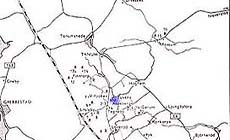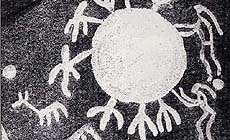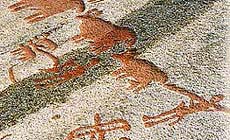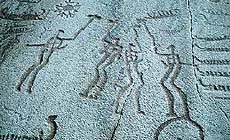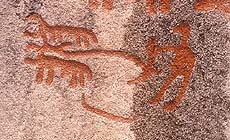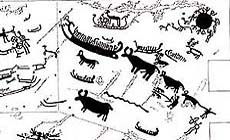|
|
 |
 |
Country: |
Sweden |
Locality: |
Tanum rań 120 |
|
 |
Region: |
Bohuslńn |
Area: |
Tanum |
|
 |
 |
|
|
|
|
| |
 |
Environment & Surface |
 |
 |
 |
|
Altitude:
|
20 m
Open-air
Shelter
Cave
Portable
Megalithic
|
Geography: |
500 m S of the large Vitlycke panel, 100 m E of road. The carving is situated at the upper level of a rather low sloping ridge. |
Proximity: |
Close to the Tanum river, situated at a rather low ridge. There is a grave field with c. 10 smaller mounds above the carved area, totally covered by pine and bush vegetation. |
|
 |
Geology: |
Granite. |
Surface: |
Sloping, rather flat surface, partly heavily damaged by weathering. |
|
|
|
|
 |
 |
|
|
|
|
| |
 |
Art |
 |
 |
 |
Description: |
Engravings
Paintings
Painted engravings
High or low-relief
Sculpture
T-12 A Tegneby 4:3 Aspeberget.
The Aspeberget rock carvings are one of the most remarkable and important localities in Scandinavia. The locality is very big, the total area of the carving runs up to several hundreds of square meters, and the lower part touches upon the 20 m a s level. The carving is divided into c. 10 rock surfaces. The total number of figures on all panels runs up to c. 400 figures.
On T-12 A, there are 66 ship figures, of which 47 has crew-strokes and 19 without. There are 16 human figures, 14 male figures, phallic, and 2 female figures with sex indicators (cup marks). There are 9 human figures with round bodies, and 7 with not rounded bodies, 9 human figures are equipped with weapon or tool, and 7 without. There are a total number of 14 weapons, of which 5 are axes, 1 bow and arrow and 8 swords.
There is 1 tool, a plough. There are 23 animal figures, of which 5 are horses, 7 deers, 3 birds, 7 oxes and 1 snake. There are 1 circle figure without cross, 2 circles with cross and 2 other. There are 4 foot prints and 36 cup marks.
|
Figures: |
total number 175
66 ship figures
16 human figures
14 weapons
1 tool
23 animals
5 circles
4 foot soles
36 cup marks.
|
|
 |
Chronology: |
Palaeolithic
Epipalaeolithic - Mesolithic
Neolithic
Copper Age
Bronze Age
Iron Age
Roman
Middle Age
Modern
Unknown
The rock carvings of Southern Scandinavia are generally dated to the middle and later part of the Bronze Age, c. 1500-500 BC. Occasionally, more absolute dating of single panels or figures can be made, based on typological or stylistic features of the image, and by comparisons with identifiable objects. The Aspberget panel are generally thought to belong to the Late Bronze Age c. 1100-500 BC.
|
Notes: |
The Aspeberget carving is one of the most remarkable and important localities in Scandinavia. It has no counterpart and is unique in its composition and variety of figures. Notable are the disc with strange symbols attached around its sides and with two human figures with long hair - women? The motif is unique in Scandinavia, a similar image are known from Northern Africa where the protruding symbols are cows or bulls guarded by women. The abundance of human figures, warriors, cattle, ships, symbols and other symbols at Aspeberget, gives us a portrait of social life, even if we can understand only a part of what we see (Bertilsson 1989:241). |
|
 |
 |
|
| |
 |
Bibliography |
 |
|
|
|
|
| |
 |
Conservation |
 |
 |
 |
Status: |
Public
Private
Park
Classified site
|
Risk: |
The major risk for rock carvings are chemical weathering, which makes the hard quartzite losen up and fall out, leaving white dots on the darker rock surface. Also natural weathering (mechanical weathering) during winter/spring, when water freeze in cracks and openings in the rock, creates major damage to rock faces with carvings. The biological weathering is also a danger to the rock carvings, and even to intense cleaning of the rock surface during documentation can make the rock fragile and expose the carvings to wind, water and air-born pollution.
Some of the figures are subject to severe weathering, caused by salt from the sea and air-born pollution. |
|
 |
Conservation: |
Good
Quite good
Mediocre
Bad
|
Intervention: |
Problems concerning conservation and preservation, registration and documentation of rock carvings in Scandinavia are discussed by several departments, i.e. Riksantikvaren in Norway, Riksantikvarieńmbetet in Sweden, several universities and research departments. Different methods are tested, for example covering of carved surfaces, measuring of temperature and different contents in water and air and also the composition in the granite. Hollows and cracks in the rock surface can be repaired and carefully filled in. An easy method of taking care of the rock surface is by ordinary sweeping. The Bronze Age environment has been restored by careful site management, mainly by clearing out pine-trees and the lower vegetation in order to create a more open and original environment. Parts of the Aspeberget locality has been covered by a roof, and some carvings has been covered by sand and earth to prevent further weathering caused by salt from the sea and air pollution. |
|
 |
 |
|
|
 |
By |
 |
|
| |
| Record n. 782 / 807 |
No commercial use is allowed. Specific ę is mentioned in the captions or owned by each Author or Institution |
|
| |
 |
EuroPreArt, European Prehistoric Art, is a web-based archaeological project funded by the European Union which aims to establish a lasting data-base of European prehistoric art documentation, to launch the base of an European institutional network and to contribute to the awareness of the diversity and richness of European Prehistoric Art.
It is proposed by: Instituto PolitÚcnico de Tomar (IPT, Portugal),
CUEBC - European University Centre for Cultural Heritage (Italy - Europe),
Consejo Superior de Investigaciones CientÝficas (España),
Asociaciˇn Cultural Colectivo Barbaˇn (España),
Université de Liège (Belgique),
Gotland University College (Sverige),
University College Dublin (Eire),
Cooperativa Archeologica Le Orme dell'Uomo (Italia),
Study Centre and Museum of Prehistoric Art of
Pinerolo (Italia),
The European Centre for Prehistoric Research in the Alto Ribatejo (Portugal),
ArqueoJovem - a youth NGO (Portugal).
|
|
|
|
 |
|
 NEW: Alpine rock paintings
NEW: Alpine rock paintings